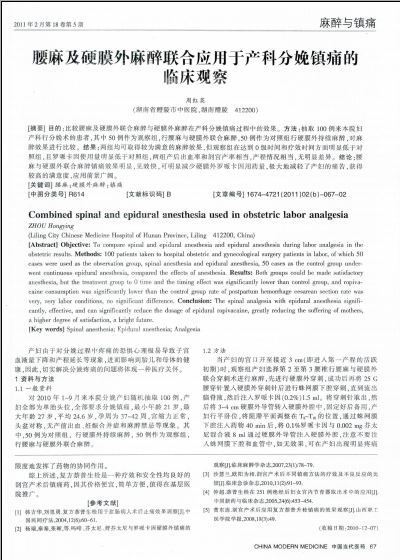腰麻及硬膜外麻醉联合应用于产科分娩镇痛的临床观察(1)
http://www.100md.com
2011年2月15日
 |
| 第1页 |
参见附件(1423KB,2页)。
[摘要] 目的:比较腰麻及硬膜外联合麻醉与硬膜外麻醉在产科分娩镇痛过程中的效果。方法:抽取100例来本院妇产科行分娩术的患者,其中50例作为观察组,行腰麻与硬膜外联合麻醉,50例作为对照组行硬膜外持续麻醉,对麻醉效果进行比较。结果:两组均可取得较为满意的麻醉效果,但观察组在达到0级时间和疗效时间方面明显低于对照组,且罗哌卡因使用量明显低于对照组,两组产后出血率和剖宫产率相当,产程情况相当,无明显差异。结论:腰麻与硬膜外联合麻醉镇痛效果明显,见效快,可明显减少硬膜外罗哌卡因用药量,极大地减轻了产妇的痛苦,获得较高的满意度,应用前景广阔。
[关键词] 腰麻;硬膜外麻醉;镇痛
[中图分类号] R614 [文献标识码] B [文章编号] 1674-4721(2011)02(b)-067-02
Combined spinal and epidural anesthesia used in obstetric labor analgesia
ZHOU Hongying
(Liling City Chinese Medicine Hospital of HunanProvince, Liling 412200, China)
[Abstract] Objective: To compare spinal and epidural anesthesia and epidural anesthesia during labor analgesia in the obstetric results. Methods: 100 patients taken to hospital obstetric and gynecological surgery patients in labor, of which 50 cases were used as the observation group, spinal anesthesia and epidural anesthesia, 50 cases as the control group underwent continuous epidural anesthesia, compared the effects of anesthesia. Results: Both groups could be made satisfactory anesthesia, but the treatment group to 0 time and the timing effect was significantly lower than control group, and ropivacaine consumption was significantly lower than the control group rate of postpartum hemorrhage cesarean section rate was very, very labor conditions, no significant difference. Conclusion: The spinal analgesia with epidural anesthesia significantly, effective, and can significantly reduce the dosage of epidural ropivacaine, greatly reducing the suffering of mothers, a higher degree of satisfaction, a bright future.
[Key words] Spinal anesthesia; Epidural anesthesia; Analgesia
产妇由于对分娩过程中疼痛的恐惧心理极易导致子宫血液量下降和产程延长等现象,进而影响到胎儿和母体的健康,因此,切实解决分娩疼痛的问题将体现一种医疗关怀。
1 资料与方法
1.1 一般资料
对2010年1~9月来本院分娩产妇随机抽取100例,产妇全部为单胎头位,全部要求分娩镇痛,最小年龄21岁,最大年龄27岁,平均24.6岁,孕周为37~42周,宫缩力正常,头盆对称,无产前出血、妊娠合并症和麻醉禁忌等现象。其中,50例为对照组,行硬膜外持续麻醉, 50例作为观察组,行腰麻与硬膜外联合麻醉。
1.2 方法
当产妇的宫口开至接近3 cm(即进入第一产程的活跃初期)时,观察组产妇选择第2至第3腰椎行腰麻与硬膜外联合穿刺术进行麻醉,先进行硬膜外穿刺,成功后再将25 G腰穿针置入硬膜外穿刺针后进行蛛网膜下腔穿刺,直到流出脑脊液,然后注入罗哌卡因(0.2%)1.5 ml。将穿刺针取出,然后将3~4 cm硬膜外导管转入硬膜外腔中,固定好后备用,产妇行平卧位,将阻滞平面调整在T8~T10的位置,通过蛛网膜下腔注入药物40 min后,将0.1%罗哌卡因与0.002 mg芬太尼混合液8 ml通过硬膜外导管注入硬膜外腔,注意不要注入蛛网膜下腔和血管中,如无效果,可在产妇出现明显疼痛症状时再注入5 ml混合液,当宫口开放至9 cm左右时 ......
您现在查看是摘要介绍页,详见PDF附件(1423KB,2页)。